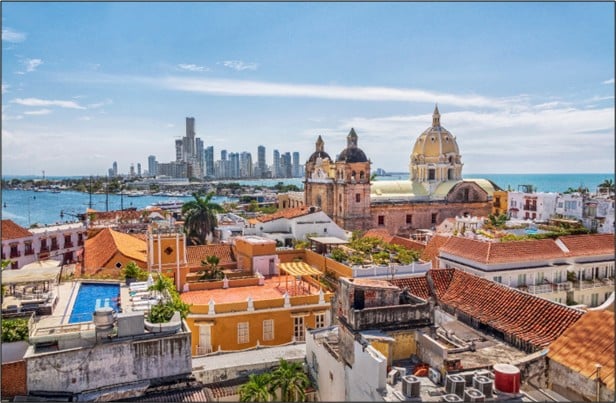The Republic of Colombia has a strategic location in Latin America. Located between the Caribbean and the Pacific, it is home to one of the world’s busiest areas of maritime traffic. In this context, its trade development has seen a notable increase in recent years.
The country’s economic structure has been strengthened thanks to good macroeconomic management, tax incentives and the inflow of foreign capital. According to the latest ICEX report, its GDP rose from $270.145 billion in 2020 to $344.000 billion in 2022. This trajectory has been modest this fiscal year. So far this year, the region’s GDP has grown by a total of 1% compared to 2022, but specifically in the third quarter of 2023, the GDP in its original series decreased by 0.3% compared to the previous fiscal year.
The activity that most contributed to the decrease in added value, according to official data from the SEN (Sistema Estadístico Nacional de Colombia [National Statistical System of Colombia]), was Manufacturing Industries, which decreased by 6.2% and contributed –0.8 points to the annual variation in added value, in its original series. Wholesale and retail trade, the automotive industry, and construction also notably contributed to this decline. Financial and insurance activities grew by 8.8% (contributing 0.4 percentage points to the annual variation).
The Consumer Price Index (CPI), as in most economies around the world, rose greatly to rates of 13.1% in 2022. This situation is also gradually being reversed. According to the latest data published by the SEN, in October 2023, the annual variation in the CPI was 10.48%, which is somewhat lower than reported variation in the same period of the previous year (12.22%).
Trade Balance
Historically, Colombia has been somewhat less open to trade compared to other countries in the area—it is usually around 25–30% of GDP—and there has always been a gap between exports and imports (mostly subject to the free import system, with less than 3% subject to the license or embargo systems). Referring to the latest published data for a full fiscal year, we found that total exports from the country in 2022 totaled $38.950 billion—most of which were fuel products and mineral oils.
Primarily supported by oil and products derived from oil—worth close to $20.000 billion in 2021—exports have fallen occasionally due to tensions between exporting countries such as Russia and Saudi Arabia. The second most imported group of products is agro-industrial products. Thanks to its climate and geographical position, Colombia produces all year round and has great potential for sustainable growth, making it one of the main producers of food such as avocados, coffee and cane.
Imports reached $77.413 billion, most of which were machinery and electrical and mechanical equipment. In 2022, the main importers from the region were the United States, Japan, Brazil, and Mexico. The primary recipient of exports is also the U.S., with 26% of the total, followed by Panama and Ecuador.
Regarding bilateral relations with Spain, since 2007, there has been an agreement for the promotion and reciprocal protection of investments (updated in 2021) and an agreement to avoid double taxation and prevent tax evasion, in addition to the Free Trade Agreement signed with the European Union in 2013. This alliance is driving an increasing investment flow, as can be seen in the chart below.

The Importance of its Culture
Tourism is a key industry for balance in Colombia, and it has established itself as a driver of economic and social development by representing about 6% of national GDP. Recently, the region’s Ministry of Trade, Industry and Tourism has presented an Industry Plan for 2022 to 2026 that seeks to aid recovery after one of the worst crises in its history, marked by events such as the pandemic. In December 2020, the Tourism Act came into force to begin alleviating the crisis by establishing tax incentives to promote the growth of the industry and reducing VAT for airline tickets from 19% to 5% until December 2022. A special tax rate was also applied for hotel construction, as well as a tax benefit for investment in environmental control, conservation and improvement.
In addition, the country wishes to boost tourism in the region sustainably, with special emphasis on the prevention and mitigation of environmental impacts, promoting social inclusion and supporting the integration of all territories. This growth began to materialize in 2022 when the country welcomed over 232% of travelers compared to 2020 (more than 4.5 million non-resident tourists). In addition, the revenue generated from this activity grew 8.6% compared to the same period prior to the pandemic. Regarding its relationship with Spain, ICEX highlights that important Spanish brands in the industry, especially hotel brands and airlines, are found in the Andean country.
Energy Landscape
The renewable energy industry in Colombia is experiencing a real boom thanks to the decided boost of the energy transition, which has the geographical advantage in the region, receiving constant solar radiation throughout the year and winds of exceptional quality. Due to its characteristics, the country is committed to achieving carbon neutrality by 2050 and reducing its greenhouse gas emissions by 51% before 2030. This boost is attracting foreign investment interested in participating in the industry’s entire value chain, both developers, marketers, input providers, consulting, construction and maintenance.
In 2022, the main source of energy generation was hydroelectricity, while the total breakdown was as follows:





